(Mfg by Gabilondo y Urresti-Eibar)
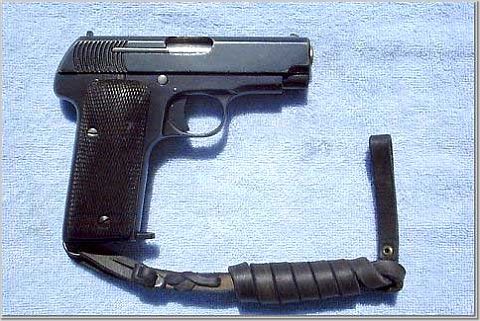
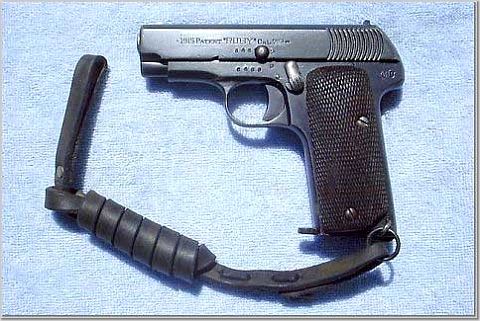
Caliber: ....................... 7.65mm Browning (32 ACP)
Barrel Length: ............. 3.43 inches (87mm)
Overall Length: ............ 6.2 inches (157mm)
Weight Unloaded: ........ 2 lbs. 14.7 oz. (875 grams)
Magazine capacity: ...... 7 to 9 rounds
Qty mfg: ..................... Estimated that 960,000 were delivered
Canadian Market Value Estimate: $
Barrel Length: ............. 3.43 inches (87mm)
Overall Length: ............ 6.2 inches (157mm)
Weight Unloaded: ........ 2 lbs. 14.7 oz. (875 grams)
Magazine capacity: ...... 7 to 9 rounds
Qty mfg: ..................... Estimated that 960,000 were delivered
Canadian Market Value Estimate: $
Observations: (by "1886lebel")
Note: Pics of revolver provided courtesy of MILSURPS.COM Advisory Panel member 1886lebel.
During WWI, called "The Great War" in Europe, "La Grande Guerre" in France, the various French military forces which had suffered severe losses in men and material in the horrible opening battles of 1914 and early 1915, forced the military authorities to look for a replacement foreign handgun for its soldiers. A reason was that the three national armories, Manufacture Nationale d'Armes de Châtellerault (MAC), Saint Etienne (MAS) and Tulle (MAT) were forced to prioritize the manufacture of rifles and machine guns for the war effort and as Northern France, the most industrialized region, was under German Occupation, the French then looked to its southern neighbor Spain for its solution. Spain which had its arms making industry setup in the northeastern Basque region was a natural source of supply for handguns as they manufactured them in calibers that were common to the various military in Europe. The French authorities decided to purchase from Spain a semi-automatic pistol called the "Ruby" or otherwise known as to the French as the Pistolet Automatique de 7 millimètre 65 genre "Ruby".
The Design
The Pistolet Automatique de 7 millimètre 65 genre "Ruby" is a simplified and relatively inexpensive copy of the Browning Model 1903 that was made by Fabrique Nationale d'Armes de Guerre au Belgique (FN). The pistol is of a blowback design with an internal hammer, in 7.65mm (32 ACP) caliber, and can hold up to nine rounds in the magazine. It differs from the Model 1903 by several details which helped to diminish the production costs by easing the manufacturing process and using materials of a lower quality. The slide has an integral breechblock and a hanging forward extension which houses the recoil spring and guide that is positioned under the barrel. The position of the dismounting cut in the slide vault in the "Ruby" was located well forward of the ejection port which permitted the barrel to not only be disengaged from the frames grooves but to be withdrawn from the pistol without having to dismount the slide. The barrel is locked to the frame using three broad lugs and grooves instead of the six used in the Model 1903 which helped in cutting the production time without sacrificing the reliability. In order to drill out the firing pin tunnel in the breechblock, the rear face of the slide had to be perforated and when completed it was sealed with a piece of rod. The firing pin is retained by means of a simple screw in the lower face of the breechblock which made it much easier to remove and re-install the firing pin. The frame has a hole drilled out in the grip behind the magazine well to house the recoil spring which is held between two riveted abutments on the guide rod. The biggest problem with this system was that the spring was not easily replaced when it wore out and a whole new assembly had to be used. When this spring gets compressed during firing the guide rod protrudes through the hole in the front end of the slide and the rear end of the guide bears up against the flat of the safety lever pivot. This arrangement was designed and patented by Pedro Careaga Garagarza in 1911.
The "Ruby" has no grip or magazine safety but there is a bulbous safety lever located on the left side of the frame just above the trigger guard. It hold the slide open when dismounting and blocks the trigger when it is in a "safe" position preventing the slide from being retracted but does not function as an hold open latch when the last round is fired. Sometime in the early 1920’s weapons overhaul period the French added a "safety knob" on left side of slide which helped to push out on the holster when holstering or upholstering to avoid moving the safety over to fire position. A wire staple lanyard loop with attached metal ring was added on the left side of heal of the butt to affix a regulation lanyard.
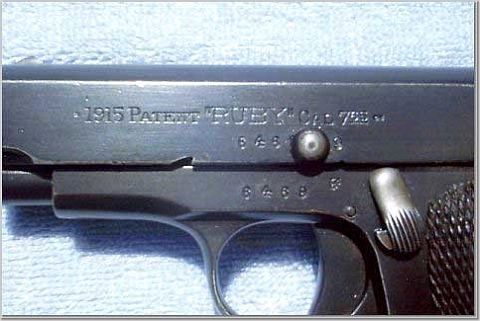
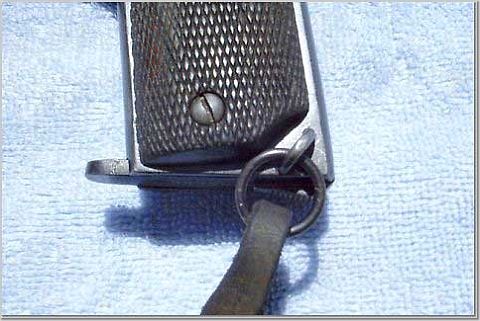
A Firm is Chosen!
The French Purchasing Commission chose the firm of Gabilondo y Urresti-Eibar to manufacture the pistol, which had began producing these weapons since 1914, as it main contract. A contract was given in the amount of 10,000 pieces a month beginning in August 1915 but it was eventually raised to 30,000 pieces. Gabilondo y Urresti-Eibar quickly realized that it would be necessary to obtain cooperation with other manufacturing firms to meet the demand so they made contracted with other Spanish companies to help manufacture the weapon. What resulted from this is that some of the smaller manufacturers, who by-passed Gabilondo y Urresti-Eibar and dealt directly with French purchasing agents, produced some lesser quality handguns that were unsafe. Some of these arms would fire when the slide ran forward to chamber a round, others fired when the safety was moved from safe to fire or even some went full automatic. Despite the small amount of unacceptable "Ruby's, Spain was able to supply enough of them to meet the French demand. All "Ruby" pistols were shipped to Manufacture d'Armes de Bayonne (MAB) where they were to be inspected and then shipped to the various units. The pistols were supposed to be marked with a star or set of stars on either side of the magazine release catch which was mark of French acceptance of foreign weapons but since these weapons were needed badly at the various fronts they did not always get this marking on them.
There are two different theories regarding how the pistols and magazines were marked in relation to the makers or trade names, in both cases the pistol was marked with single or double block letters on the left rear frame tang and the base of the magazine. The reason for the magazines markings was it was found that the "Ruby" pistol magazines were not really all that generic as they varied from manufacturer to manufacturer and was done to make certain that the pistol had a magazine that fit and feed properly.
The first was that all pistols that were sent to France during the war were normally marked with either single or double block letters within an oval circle and after the war they were just marked with just the single or double block letters without the oval circle. The magazines were then marked sometime late in the war or after the war.
The second is that makers and trade name codes were added to both the pistols and magazines at the same time but what is not clear is when this was done but believed to have been during the early 1920’s overhauls.
A full set of serial numbers were for the most part normally placed on the left side of the slide and frame but as in some instances some can be found without numbers on the frames, no serial numbers at all or on the right side of either the slide or frame. As a great deal of hand fitting was required for most of the internal parts it was necessary to mark these parts with a totally unrelated internal assembly number to be sure that these parts were devoted to a specific pistol. The under face of the barrel, under face of the safety lever, inside of the slide near the firing pin well, left side of the frame near the grip, left side of magazine catch, right side of trigger and the underside of the disconnector were marked with these assembly numbers. Magazines sometimes were also marked with the serial number for reasons stated above.
NOTE: As there were over 30+ companies that manufactured these pistols, listed below is some of the different companies that manufactured these pistols, some of these were made during the post-war years and some are in 6.35mm (25 ACP) caliber. The ones listed with bold letters are the manufacturer codes that were referred to above.
Acha y Cia, Eibar … "Acha"
AH and AR: Acha Hermanos, Eibar or Ermunda ... "Looking Glass", sometimes the trade name was not used *Pistols marked "Looking Glass" seem to be post-WWI made*
Domingo Acha, Eibar ... "Triplex"
Aguirre y Cia, Eibar ... "Basculant", "Le Dragon"
AL: Aldazabal, Leturiondo Y Cia, Eibar * ... "Aldazabal", sometimes the trade name was not used
A. Aldazabal, Eibar * … "A.A.A."
José Aldazabal, Eibar * ... "Imperial"
Armas de Fuego, Guernica ... "Alkartasuna"
AK: Fabrica de Armas Alkartasuna, SA, Guernica ... "Alkar", "Kapitan"
V. Fabrica De Armas, Durango ... "Vencedor"
AE: La Armeria Elgoibaresa, Eligobar ... "Lusitania"
Apaoloza Hermanos, Zumorraga ... "Apaoloza", "Triomphe"
Apaolozo Hermanos, Eibar ... "Paramount"
Arana y Cia, Eibar ... "El Cano"
Ariola Hermanos, Eibar ... "Ariola"
A: Gaspar Arizaga, Eibar ... "Arizaga", "Misdial", "Pinkerton", "Warwinch", sometimes the trade names were not used
AG: Francisco Arizmendi y Goenaga, Eibar ... "Ideal", "Roland", "Brunswig"
Arizmendi y Goenaga, Eibar ... "F.A.", "F.A.G.", "Teuf-Teuf", "Waldman"
AZ: Arizmendi, Zulaica y Cia, Eibar ... "Cebra", some may be over stamped "Beistegui Hermanos"
Francisco Arizmendi, Eibar ... "Arizmendi", "Roland", "Singer", "Victor", "Ydeal"
F. Arizmendi, Eibar ... "Boltun", "Guerre", "Kaba Special"
Armero Espacialitas Reunidos, Eibar ... "Alfa", "Omega"
Hijos de C. Arrizabalaga, Eibar ... "Arrizabalaga", "Campeon", "Especial"
J. Arrizabalaga, Eibar ... "Esmi"
AA: Azanza y Arrizabalaga, Eibar * … "A.A. Reims", "Modelo 1916"
Hijos de Calixto Arrizabamaga, Eibar ... "Sharpshooter", "Terrible"
EA: Arostegui Eulogio, Eibar ... "Azul", "E.A.", "Oscillant-Azu"
S. Arostegui, Eibar ... "Browreduit"
Aspiri y Cia, Eibar ... "Avion", "Colon"
Astra Unceta y Cia, Guernica ... "Astra", "Cadix", "Camper"
Barrenechea y Gallastegui, Eibar ... "Barrenechea"
Hijos de Jorge Bascaran, Eibar ... "Marke", "Martigny"
MA: Martin Bascaran, Eibar ... "Martian", "Thunder M1919"
MB: Fa de Martin A. Bascaran, Eibar ... "Martian"
BH: Beistegui Hermanos, Eibar ... "Beistegui", "B.H.", "Bulwark", "Libia", "Paramount", "1914 Model Automatic Pistol"
BC: Victor Bernedo y Cia, Eibar ... "B.C.", "Bernedo", sometimes the trade names were not used
VB: Victor Bernado y Cia, Eibar. No trade names used. *Some may have extended barrels*
BA: Fab. de Bersaluzze Arieto-Aurena Y Cia, Eibar ... "Allies"
GB: Gregorio Bolumburo, Eibar ... "Deluxe", "Gloria", "Giralda", "Marina", "Regent", "Regina", "Rex"
G. Bolumburu, Eibar ... "Bolumburo", "Bristol"
Crucelegui Hermanos, Eibar ... "Brong Petit", "Bron-Sport", "C.H.", "Le Brong", "Puppy"
JE: Javier Echaniz, Eibar ... "Defender"
Echave y Arizmendi, Eibar ... "Basque", "Bronco", "E.A.", "Echasa", "Lightning", "Lur-Panzer", "Pathfinder", "Protector", "Renard", "Selecta M1918", "Selecta M1919", "Vite M1913", "Vite M1914", "Vite M1915"
I: Bonifacio Echeverria, Eibar ... "Estrella", "Izarra", "Star", "Vesta"
HE: Hijos de A. Echeverria, Eibar ... "Vesta" (code may also be marked on slide), "Izarro"
EC: Ergulaga y Cia, Eibar ... "Fiel"
Manuel Escodin, Eibar ... "Escodin"
Esperanza y Cia, Guernica ... "Astra"
Esperanza y Unceta, Eibar ... "Astra:, "Campo Giro"
EU: Esperanza y Unceta, Guernica ... "Model 1915" ( or 1916 ), "Astra Patent", "Brunswig Model 1916", "Victory"
Antonio Errasti, Eibar ... "Dreadnought", "Errasti", "Oicet", "Smith Americano"
A. Errasti, Eibar ... "Broncho"
Esprin Hermanos, Eibar ... "Euskaro"
Gabilondo y Cia, Eibar or Elgoibar ... "Danton", "Guisasola", "Mugica", "Perfect", "Plus Extra"
GU: Gabilondo y Urresti, Eibar or Elgoibar ... "Bufalo", "Gabilondos", "Radium", "Ruby", "Ruby Extra", "Tauler"
Fab. de Armas Garantizada, Eibar ... "Apache", "Garantizada", "Rural"
GN: Garate, Anitua y Cia, Eibar ... "Danton", "El Lunar", "Express", "GAC", "Garate", "G.N.", "La Lira", "L'Eclair", "Sprinter", "Tigre", "Triumph"
Garate Hermanos, Eibar or Ermua ... "Cantabria", "Velostark"
Gastanaga, Trocaola y Cia, Eibar ... "T.A.C.", "Trocaola"
IG: Isidrio Gatzanaga, Eibar ... "Destroyer", "Gazantanaga", "Horse Destroyer", "Indian", "Sureté"
IS: Iraola y Salaverria y Cia ... No trade names used
Fab. d'armes de Grande Précision, Eibar ... "Bulwark", "Colonial", "Grande Précision", "Helvece", "Jupiter", "Minerve", "Trust"
Guisasola Hermanos, Eibar ... "G.H.", "Guisasola"
LC: Laplana y Capdevila ... Trade names are unknown
Larranaga y Elartza, Eibar ... "Jubala", "L.E."
LH: Lasangabaster Hermanos, Eibar ... "Douglas"
Lascauren y Olasola, Eibar ... "El Perro"
Manufactura de Armas "Demon", Eibar ... "Demon"
Mendiola, Eibar ... "Vainquer"
Erquiaga Muguruzu y Cia, Eibar ... "Diane", "Fiel"
Urquiaga y Muguruzu, Eibar ... "Marte"
Obrea Hermanos, Eibar ... "Colon", "Iris", "La Industrial", "O.H.", "Orbea", "Perfecto"
Cooperativa Obrera, Eibar ... "Longines"
IO: La Industria Obrea, Eibar ... No trade names used
Ojanguren y Marcaido, Eibar ... "Brow", "O.M."
Ojanguren y Vidosa, Eibar ... "Apache", "Crucero", "Furia", "Militar Y Policia", "Ojanguren", "Puppet", "Salvaje", "Tanque"
Onandia Hermanos, Eibar ... "Onandia"
F. Ormachea, Eibar ... "Bron-Grand", "Duan", "Merke"
Orueta Hermanos, Eibar ... "Oculto", "Tanker"
RH: Retolaza Hermanos, Eibar ... "Brompetier", "Gallus", "Liberty", "Military", "Paramount", "Puppy", "Retolaza M1914", "Stosel", "Titan", "Titanic", "Titanic M1914", "Velo-Brom", "1914 Model Automatic Pistol"
Santiago Salaberrin, Eibar ... "Etna", "Invicta", "Protector", "Tisan", "Unis"
Iraola Salaverria y Cia, Eibar ... "Destructor", "Iraola", "Salaverria"
Casimir Santos, Eibar ... "El Cid", "Vencedor"
MS: Modesto Santos, Eibar … "Action", "M.S."
S.E.A.M., Eibar ... "Praga", "Regent", "Silesia", "Sivispacem", "Waco"
Suinaga y Aramperri, Eibar ... "S&A"
Unceta y Cia, Guernica ... "Brunswig", "Fortuna", "Leston", "Liégeoise", "Museum", "Salso", "Union", "Victoria"
Union Armera Eibaressa, Eibar ... "U.A.E."
Union Fab. de Armas, Eibar ... "Rival M1913"
Tomas de Urizar, Eibar or Barcelona ... "Continental", "Dek-Du", "Express", "Imperial", "La Basque", "Le Secours", "Phoenix", "Premier", "Princeps", "Puma", "Union", "Venus"
UC: Urrejola y Cia, Eibar ... "U.C.", "Urrejola"
ZC: Zulaica y Compania or Cia, Eibar ... "Royal", "Victory", "Vincitor M1914", "Vincitor M1914 No.2", "Zulaica M1914"
Zuloga y Cia, Eibar ... "Volontaire"
Zumorraga y Cia, Eibar ... "Paramount"
CU: unknown
CZ: unknown
RG: unknown
TM: unknown
VD: unknown
Unknown Makers ... "Aurora", "Boix", "Burgham Superior", "Ca-Si", "Cobra", "Mosser", "Muxi", "Oyez", "Peerless", "Rayon", "R.E.", "Reform", "Republic", "Rex", "S.M.", "Tatra", "Velo-Mith", "Velosmith", "Vilar", "Vulcain", "Zwylacka"
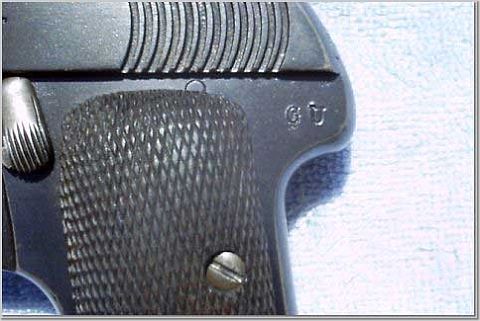
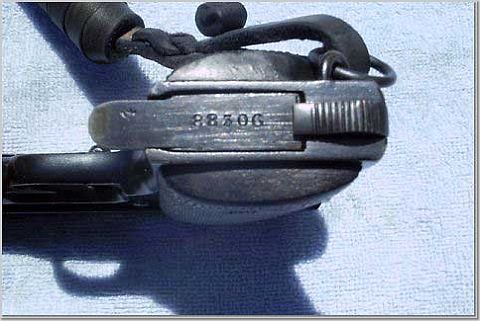
Numbers Made and Usage
It is impossible to know how many of these pistols were actually delivered to France as most of the records were either destroyed during the bombings of WWII in France or in Spain during the Spanish Civil War but it is estimated that approximately 960,000 were delivered.
The Pistolet Automatique de 7 millimètre 65 genre "Ruby" was used in the later mandate and territorial colonies conflicts such as Syria and North Africa. During the Second World War they were used during the campaigns of 1939-40 and later by both the Free and Vichy French forces. After WWII they were once again employed in the wars in both Indochina and Algeria. Many of these pistols were surrendered or captured during the War in Indochina and were used by the Viet-Cong and North Vietnamese Army during the Vietnam War.
These pistols were also delivered to Italy, Greece, Romania, Serbia and Russia during the First World War. After the First World War France re-built many of these pistols and sold them to the various newly created nations such as Poland and Finland.
Accessories
Holsters
There were two different types of holsters used by the French Army for these weapons, the Etui modèle 1916 and Cartouchière porte pistolet modèle 1888 modifié 1915.
• The Mle.1916 was made from heavy leather and is constructed in the form of a right triangle. One piece forms the back and folds over as the protective front flap; another is used for the front. A flexible strip of leather is used between the two forming the sides, an elongation of the strip forms a small flap at the left side and a longer extension on right side helps protect the interior. A small strip was either sewn or riveted on to the left side of the holster that runs diagonally across which fastened to a metal stud on the lower front of the flap, closing the holster. A wire loop was sometimes attached to the back of the holster which is then secured to a J-hook of the Y-straps used to hold it firmly in place from slipping when it was placed on the waist belt. Some of these holsters had metal D-rings attached to the sides or rear of the holster for a shoulder strap. On the inside left corner are two magazine pouches. The holsters were marked one or two ink stampings signifying the manufacturer and receiving military facility. Sometimes these were marked to various units they went to.
• The Mle.1888/1915 was shaped like the standard rectangular leather infantry pouch but slightly larger in size with the wire loop described above. On the inside rear left side were two magazine pouches. These holsters were also marked with the one or three ink stampings. These holsters were normally only issued to Mle.1915 CSRG gunners and assistants and were worn on the back attached to the waist belt and Y-straps.
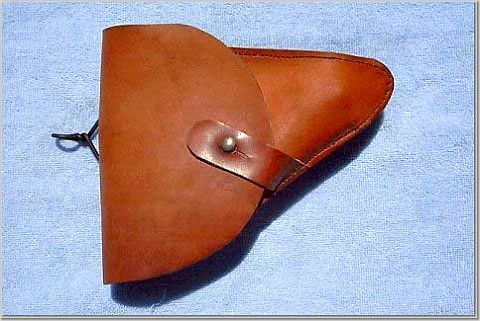
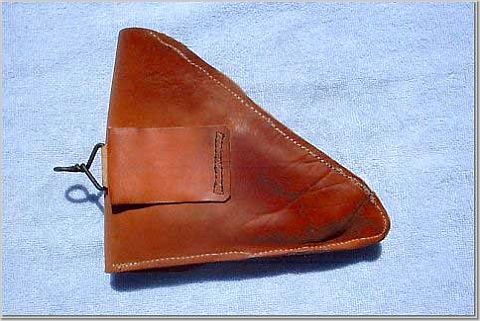
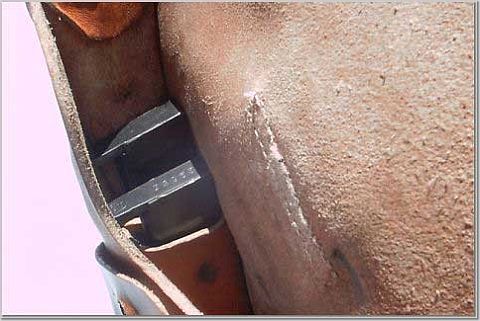
Lanyards
There were two different types of lanyards used by the French Army for these weapons.
• A standard pre-WWI regulation leather revolver lanyard was used. The lanyard was about 29 inches long (74.9cm) and 7/16 inch wide (1.1cm). The loop end of the lanyard was closed by a brass rivet and was intended to be attached to the belt. The other end was secured to the pistol by means of a hard leather knot that runs through a slit at the end of the strap. These were normally left in the natural leather but occasionally were dyed black.
• The second type lanyard used was of post-WWI design which was almost identical to the above mentioned type but the ends were closed by means of either a brass rivet or sewn together. A metal snap and D-Ring was used enabling it to be fastened to the staple on the heel of the butt. These were normally left in the natural leather but occasionally were dyed black or white.
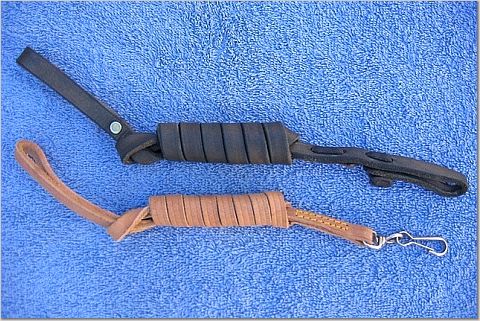
Cleaning Kit
The standard cleaning kit called Nécassaires d'armes modèle 1874 which was originally designed for the Revolver d’Ordnance Modèle 1873 was used for this pistol. It consisted of the following items:
• Grease box (boîte à graisse): This is a two part tin container with double sided hinged lids. In one compartment grease is stored and in the other a brass string-pull through section (ficelle individuelle de nettoyage) along with extra small bits of rag was stored.
• Cleaning brush (brosse de armes)
• Cleaning kit container (boitier du nècessaire) and oilier (huiler): This hollow steel container is where all the smaller tools are stored, such as the double headed screwdriver (tournevis) and the grease and oil mixing tool (spatule curette) which was flattened on one side and doubled as a carbon scraper. Both of these tools are stored in small black, brown or navy blue pouch called a truss (trousse) which has separate dividers to place the tools in so that when they are stored in the container they will not slip through the slot in the top. The top of the container has a slot on the top where the screwdriver fits into so that it may be used as a handle. The bottom is the oil container which has a plug that can be unscrewed with a small leather washer on it to prevent it from leakage. The post-war kits also contained in them an articulated bore brush (ècouvillon articulé) which was tied to the string pull through section and pulled through the barrel and a pin punch (chasse-goupilles) to help drive out the different pins in the weapon. These containers were often serialized as to keep track of them.
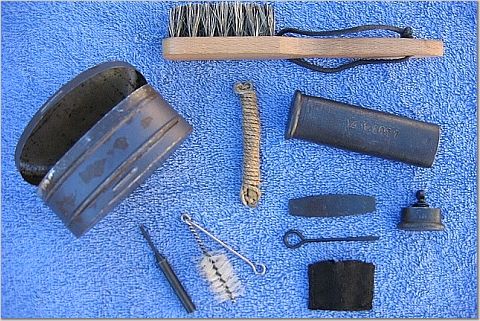
Who They Were Issued To
According to the 1917 and 1918 regulation French Infantry Squad Leader's Handbooks (Manuel de Chef de Section d'Infanterie) it says that the "Ruby" Pistol was issued to Telephonists, Stretcher Bearers, Mle.1915 CSRG gunners and assistants, and 37mm Mortar Crew. In the 1918 manual it also lists them being issued to Tank Crewmen.
Characteristics:
The pistol is an semi-automatic loaded weapon, the barrel is fixed and rests in the slide
It is divided in two parts:
The first is the stationary one which composes of the following, the barrel, the frame and trigger mechanism
The other is moving which composes of the following, the slide and recoil spring and guide.
Precautions to take: Turns out these guns present a common danger, which has caused many serious accidents. Do not believe that the weapon is unloaded because one withdrew the magazine; because a cartridge can still remain in the barrel. It therefore is necessary the extract the round from the barrel. Then, only, the weapon is emptied.
Caractéristique:
Le pistolet est une arme à chargement automatique, à canon fixe et à long recul de la culasse.
Il se divise en deux parties:
L'une fixe comprend: le canon, la carcasse et les mécanismes de détente, d'alimentation, de percussion;
L'autre mobile comprend: le bloc de culasse et son ressort récupérateur.
Précautions à prendre: Tours ces pistolet présentent un danger commun, qui a déja causé de nombreux accidents.
Ne pas croire que l'arme est déchargée parce qu'on a retiré le chargeur; il reste encore généralement une cartouche dans le canon. Il faut l'extaire en tirant le canon en arrière. Alors, seulement, l'arme set vide.
Nomenclature:
The Pistolet Automatique de 7 millimètre 65 genre "Ruby" is composed of the following principal parts:
The frame, of which the various mechanisms are brought up on;
The slide, which houses the extractor, the firing pin and its rebounding spring, the rear and front sights;
The barrel;
The lock mechanism, which contains the trigger, the trigger bar, sear, and hammer with its spring;
The recoil spring and recoil guide;
The safety;
The grips and its screws;
The magazine and magazine release catch
Nomenclature
Les pistolets automatiques de 7mm65 genre "Ruby" se composent des parties principales suivantes:
La carcasse, sur laquelle est monté l'ensamble du mécanisme;
Le bloc de culasse, portant l'extracteur, le percuteur et son ressort de rebondissement, le cran de mire et le guidon;
Le canon;
Le mécanisme de platine, comprenant la détente et sa barrette, la gâchette et le chien avec leur ressort;
Le ressort récupérateur et son guide;
Le système de sûreté;
Les plaquettes et leurs vis;
Le chargeur et son crochet.
Disassembly and Reassembly:
Disassembly :
To withdraw the magazine from the grip of the frame, slide the magazine release catch fully to the rear and at same time withdraw the magazine.
Precautions to take: It turns out these guns present a common danger, that has caused many serious accidents. Do not believe that the weapon is unloaded because one withdrew the magazine; because a cartridge can still remain in the barrel. It therefore is necessary the extract the round from the barrel. Then, only then is the weapon is considered emptied.
With the above precaution and to avoid an accident, pull the slide fully to the rear to extract any cartridge that may be in the chamber.
Rotate the safety lever over the letter "F" and this will help hold the slide in the rear position.
To remove the barrel, use the following procedure, turn it from left to right, then pull it forward, then rotate it from right to left and this will allow it to be completely removed from the slide.
To remove the slide from the frame, slightly pull the slide to the rear and then forward and this will release the slide from the frame then , remove the slide from the frame.
The recoil spring and guide then can be removed from the frame.
The right grip then can be removed for maintenance.
This is as far as the weapon is disassembled for normal cleaning and lubrication.
Reassembly:
Proceed as for disassembly but in the reverse order
Maintenance:
Cleaning:
The pistol having been disassembled to the above procedures, clean the rails of the frame and slide, all accessible parts of the trigger mechanism, wipe the interior and exterior of the barrel, and clean the magazine.
Lubrication:
Lightly oil the hammer notch, the rails of the frame and slide, the trigger mechanisms, exterior of the barrel and exterior of the weapon it self.
Démontage et Remontage
a) Démontage
1. Retirer le chargeur de la poignée, puis, précaution essentielle en vue d'éviter tout accident, porter complètement en arrière le blos de culasse de manière à extraire la cartouche qui peut se trouver encore dans la chambre;
2. Disposer le levier de la sûreté de manière à lassier apparaître la lettre F et faire reculer le bloc le plus possible;
3. Enlever le canon ; à set effet, le faire tourner de gauche à droite; le tirer en avant; lui donner une nouvelle rotation de droite à gauche et le dégager en fin complètement du bloc de culasse;
4. Enlever le bloc, puis le ressort récupérateur et la plaquette gauche, sans pousser plus loin le démontage.
b) Remontage
Procéder comme pour le démontage et dans l'ordre inverse
3. Entretien
a) Nettoyage
Le pistolet ayant été démonté comme il été dit ci-dessus, nettoyer avec soin les glissières de la carcasse et du bloc de culasse, ainsi que toutes les parties accessibles du mécanisme. Essuyer le canon à l'intérieur et à l'extérieur. Nettoyer le chargeur
b) Graissage
Huiler légèrement le cran du chien, les glissières de la carcasse et du bloc, ainsi que le mécanisme de détente.
Employment:
a) To load the weapon, slide the magazine release catch fully to the rear. Introduce a magazine with 7 or 9 cartridges (depending on capacity) and place it in the frame of the pistol. Pull the slide all the way to the rear which will cock the hammer and compress the recoil spring. Allow the slide to slide forward under the action of the recoil spring and a cartridge will be stripped from the magazine into the chamber of the barrel. The weapon is now ready to fire.
b) As you pull the trigger gas pressure from the fired cartridge drives against the breechblock which allows the slide to begin sliding backward, as it slides backwards the extractor then ejects the spent cartridge case. A new round from the magazine is then pushed forward into the chamber when the recoil spring forces the slide back forward, this will allow the shooter to continue to fire as long as the trigger is engaged or until all rounds have been fired from the magazine.
c) To put the weapon on safe when a cartridge is in the barrel rotate the safety on the left side of frame upwards to cover the letter F and expose the letter S.
d) To put the weapon back into the firing mode from the safe position rotate the safety in the opposite direction to cover the letter S and expose the letter F.
F or the words (Fire, Feu)
S or the words (Save, Safety or Sûreté)
Emploi
a) Pour charger l'arme, dégager de la poignée le chargeur-magasin en agissant sur son crochet d'arrêt.
Introduire une à une dans le chargeur 7 ou 9 cartouches (suivant sa contenance) et replacer celui-ci dans la poignée.
Retirer le bloc de culasse complétement en arriére, déplacement d'où résultent l'armé du chien et la compression du ressort récupérateur.
Abandonner le bloc qui, revenant en avant sous l'action de son ressort, introduit dans la chambre la cartouche supérieure du chargeur.
L'arme est prête à faire feu.
b) Si l'on appuie alors sur la détente, le départ se produit et la gaz de la poudre, agissant sur le bloc, font reculer ce dernier; en même temps, l'étui vide, saisi par l'extracteur, est éjecté. Le bloc se porte de nouveau en avant et la mouvements décrits ci-dessus se reproduisent tant qu'il reste des cartouches dans le chargeur ou dans la chambre, pourvu quele tireur ait soin, après chaque coup, de laisser la détente revenir en avant.
c) Pour mettre l'arme à la sûreté, lorsqu'une cartouche se trouve dans la chambre, disposer le levier monté sur le côté gauche de la carcasse de manière à masquer la lettre F et à laisser apparaître la lettre S
d) Pour mettre en état de faire feu l'arme disposée à la sûreté, agir en sens inverse sur le levier pour recouvrir la lettre S ou rendre visible la lettre F
F ou le mot (Fire, Feu)
S ou le mot (Save, Safety, Sûreté)
Sources:
Artillerie; Armes Portatives; Instruction sur La Nomenclature, L'Emploi, Le Démontage et L'Entretien des Pistolets Automatiques de 7m/m 65 en Service; Ministère de La Guerre 1916 - 20 Janvier
Manuel du Chef de Section d'Infanterie 1916, 1917 and 1918
Le Livre du Grade D'Infanterie à L'usage des Élèves Caporaux, Caporaux et Sous-Officier de L'Infanterie et du Génie; 1917
Military Handguns of France 1858-1958; Eugene Medlin and Jean Huon; Excalibur Publications; 1993
The Spanish Ruby Pistol Explained; Gérard Hentrotin; E-Book G. Hentrotin & H&L Publishing (Belgium); 2004
Acknowledgments:
F.Xavier-Bernard
Colin Doane
Tom Knox
Dale Martin
Eugene Medlin
Robert Skrivan
Collector's Comments and Feedback:









 Reply
Reply
 Countries
Countries Categories
Categories Recent Article Comments
Recent Article Comments

